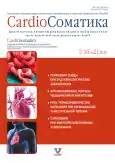Investigation of triiodothyronine, thyroxine, and thyroid-stimulating hormone levels’ influence on atrial myocardial electrical instability in experimental hypothyroidism
- 作者: Rakhmatullov R.F.1, Dementeva R.E.1, Sheina A.E.1, Kondrateva K.P.1, Rakhmatullov F.K.1, Melnikova L.V.2
-
隶属关系:
- Penza State University
- Russian Medical Academy of Continuous Professional Education
- 期: 卷 16, 编号 2 (2025)
- 页面: 106-114
- 栏目: Original study articles
- URL: https://journal-vniispk.ru/2221-7185/article/view/309741
- DOI: https://doi.org/10.17816/CS676542
- EDN: https://elibrary.ru/GCWVYC
- ID: 309741
如何引用文章
全文:
详细
BACKGROUND: Identifying the association between thyroid dysfunction and the development of nonvalvular atrial fibrillation (AF) remains one of the complex and pressing issue in contemporary cardiology. To date, only a limited number of studies have examined the relationship between AF and the hypothalamic-pituitary-thyroid (HPT) axis, and the available findings are often contradictory. Few papers have explored the association between AF and HPT axis in experimental conditions.
AIM: The work aimed to evaluate the association between AF and the HPT axis in experimental models of hypothyroidism, euthyroidism, and thyrotoxicosis in rats.
METHODS: The study included 146 outbred rats. Group 1 comprised 42 rats with euthyroidism. Group 2 included 15 rats with overt thyrotoxicosis. Group 3 included 22 rats with subclinical thyrotoxicosis. Group 4 comprised 67 rats with euthyroid sick syndrome. The methods included electrocardiographic monitoring and measurement of thyroid hormone concentrations.
RESULTS: The frequency of AF paroxysms was found to depend on thyroid hormone levels: under euthyroid conditions, on thyroid-stimulating hormone (β = −0.250; p < 0.001) and thyroxine (β = 0.838; p = 0.012); in overt thyrotoxicosis, on thyroxine (β = 0.732; p = 0.00008) and triiodothyronine (β = 0.352; p = 0.043); and in subclinical thyrotoxicosis, on thyroxine (β = 2.1; p = 0.0002) and triiodothyronine (β = −0.970; p = 0.019). Threshold values of thyroid hormones were determined for euthyroid, subclinical, and overt thyrotoxic states.
CONCLUSION: A relationship between atrial fibrillation and thyroid functional status was established.
作者简介
Ruslan Rakhmatullov
Penza State University
Email: capitalofgreat@icloud.com
ORCID iD: 0000-0002-2157-544X
SPIN 代码: 5748-7530
MD, Cand. Sci. (Medicine), Associate Professor
俄罗斯联邦, PenzaRenata Dementeva
Penza State University
编辑信件的主要联系方式.
Email: rdementyeva@gmail.com
ORCID iD: 0000-0003-1497-5338
SPIN 代码: 8461-0433
MD, Cand. Sci. (Medicine), Assistant Professor
俄罗斯联邦, 40 Krasnaya st, Penza, 440026Alina Sheina
Penza State University
Email: alina_silukova@mail.ru
ORCID iD: 0000-0002-9373-7268
SPIN 代码: 5785-5658
俄罗斯联邦, Penza
Kristina Kondrateva
Penza State University
Email: free-tina@yandex.ru
ORCID iD: 0000-0002-8540-2054
SPIN 代码: 4214-9987
俄罗斯联邦, Penza
Fagim Rakhmatullov
Penza State University
Email: pgu-vb2004@mail.ru
ORCID iD: 0000-0002-2587-8325
SPIN 代码: 3232-7425
MD, Dr. Sci. (Medicine), Professor
俄罗斯联邦, PenzaLudmila Melnikova
Russian Medical Academy of Continuous Professional Education
Email: pgu-vb2004@mail.ru
ORCID iD: 0000-0003-4688-1272
SPIN 代码: 6907-5327
MD, Dr. Sci. (Medicine)
俄罗斯联邦, Moscow参考
- Sagris M, Vardas EP, Theofilis P, et al. Atrial Fibrillation: Pathogenesis, Predisposing Factors, and Genetics. Int J Mol Sci. 2021;23(1):6. doi: 10.3390/ijms23010006 EDN: HLEQZD
- Ferreira M, V Geraldes, Felix AC, et al. Advancing atrial fibrillation research: the role of animal models, new technologies and challenges for translational medicine. Biomedicine. 2025;13(2):307. doi: 10.3390/biomedicines13020307 EDN: SMPMXL
- Marusenko IM, Petrova EG. Hyperthyroidism and Atrial Fibrillation. Rational Pharmacotherapy in Cardiology. 2017;13(3):398–402. doi: 10.20996/1819-6446-2017-13-3-398-402
- Demidova TY, Drozdova IN. Influence of subclinical hyperthyroidism on the cardiovascular system. Clinical and experimental thyroidology. 2015;11(2):33–37. doi: 10.14341/ket2015233-37 EDN: UHMYYH
- Kostopoulos G, Effraimidis G. Epidemiology, prognosis, and challenges in the management of hyperthyroidism-related atrial fibrillation. Eur Thyroid J. 2024;13(2):e230254. doi: 10.1530/ETJ-23-0254
- Kryzhanovskii SA, Tsorin IB, Ionova EO, et al. “Holiday heart” syndrome in rats: Features of microcirculation, functional state and anatomy of the heart. Pharmacokinetics and pharmacodynamics. 2024;(2):26–33. doi: 10.37489/2587-7836-2024-2-26-33 EDN: EYQMSH
- Abrashova TV, Sokolova AP, Selezneva AI, et al. Variability of biochemical and hematological parameters in laboratory rats depending on the line and age. International Bulletin of Veterinary Medicine. 2010(2):55–60. EDN: MTWSDP
- Abisheva ZS, Zhurunova MS, Dautova MB, et al. Influence of young individuals blood to the adult rats blood indicators under experimental conditions. International Journal of Applied and Fundamental Research. 2017;1(2):228–231. EDN: XXDXLB
- Rakhmatullov RF, Melnikova LV, Moiseeva IYa, Rakhmatullov FK. A pharmacotherapy of atrial fibrillation in subclinical thyrotoxicosis. University proceedings. Volga region. Medical sciences. 2021;(2):35–48. doi: 10.21685/2072-3032-2021-2-4 EDN: BDHKBR
- Ramirez RJ, Bergman SJ, Masri JA. Experimental and Computational Models of Atrial Fibrillation. From Supraventricular Tachycardia to Cardiac Resynchronization Therapy; 2024. doi: 10.5772/intechopen.113726
- Vaikhanskaya TG, Kaptiukh TM, Kozlov ID, Frolov AV. Interatrial block and abnormal p-wave electrocardiographic parameters as non-invasive predictors of atrial fibrillation. Journal of Arrhythmology. 2024;31(2):24–34. doi: 10.35336/VA-1329
- Giovanella L, Petranović Ovčariček P. Functional and molecular thyroid imaging. Q J Nucl Med Mol Imaging. 2022;66(2):86–92. doi: 10.23736/S1824-4785.22.03428-8 EDN: UZWMON
- Dementieva RE, Rakhmatullov FK, Sheina AE, et al. Morphological and electrocardiographic criteria for myocardial fibrosis and atrial fibrillation. Izvestiya vysshikh uchebnykh zavedeniy. Povolzhskiy region. Meditsinskiye nauki. 2024(2):73–84. doi: 10.21685/2072-3032-2024-2-7 EDN: OLPLLN
- Cappola AR, Fried LP, Arnold AM, et al. Thyroid status, cardiovascular risk, and mortality in older adults. JAMA. 2006;295;(9):1033-1041. doi: 10.1001/jama.295.9.1033
- Voloshan OA, Gorshkov DA, Petrova OV, et al. Determination of blood parameters of laboratory rats with the formation of a regional protocol for experimental studies. Astrakhan Medical Journal. 2023;1(2):47–54. doi: 10.29039/1992-6499-2023-2-47-54 EDN: HQBSJE
- Tribulova N, Kurahara LH, Hlivak P, et al. Pro-Arrhythmic Signaling of Thyroid Hormones and Its Relevance in Subclinical Hyperthyroidism. Int J Mol Sci. 2020;21(8):2844. doi: 10.3390/ijms21082844 EDN: CDEUGG
- Rakhmatullov RF, Kondratieva KP, Sheina AE. Changes of the Heart Rhythm in Imbalance of Thyroid Gland Hormones and its Morphology in Outbred Rats. Kardiologiia. 2024;64(10):24–31. doi: 10.18087/cardio.2024.10.n2675 EDN: AOARDJ
- Collet TH, Gussekloo J, Bauer DC, et al. Subclinical hyperthyroidism and the risk of coronary heart disease and mortality. Archives of Internal Medicine. 2012;172(10):799–809. doi: 10.1001/archinternmed.2012.402
补充文件











